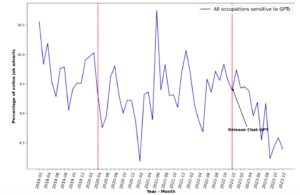Chat-GPT and the UK Labour Market: A Year in Review
Jeisson Cardenas-Rubio and Gianni Anelli-Lopez
University of Warwick Institute for Employment Research
It is now one-year since the release of Chat-GPT, an artificial intelligence tool which has raised lots of questions about how GPTs (Generative Pre-trained Transformers) in general might affect the demand for labour. Building on the previous blog “From Automation to Adaptation: Jobs at Risk of Exposure to AI in the UK” this blog extends on the previous analysis to show how things have developed over the past six months or so incorporating fresh insights with data up to December 2023. Initially, the analysis did not show any clear impact of Chat-GPT on job prospects. However, with data now covering a 12-month period, there are tentative indications that the situation could be changing.
The Unfolding Tale: A Downward Trajectory Emerges
The initial exploration of how GPTs affects particular jobs revealed that pessimistic predictions were premature. Six months into the influence of Chat-GPT, no observed changes of significance on the demand for labour and skills were detected. With a year’s worth of data now available, the picture is gaining more perspective. Figure 1, now extended to December 2023, begins to reveal a subtle yet persistent decline in the share of online job advertisements (OJAs) for jobs considered to be sensitive to the diffusion of GPTs (i.e. jobs where tasks can be automated or augmented by the widespread adoption and integration of GPTs).
Figure 1. Annual Trends in GPT-Sensitive Occupations

The trend in the UK labour market for Chat-GPT-sensitive occupations in 2023 shows a general decline with periodic and modest recoveries in between. The year began with a peak vacancy rate of 9.7% in January, the highest rate for the months that followed. As the year progressed, a declining trend became apparent, with the rate decreasing to 8.5% in July and further to 8.2% in September, which was the lowest rate of the year. This was close to the previous low of 8.1% seen in February 2021. Although there were slight increases, such as a rebound to 9.1% in August, the general trend continued to show a modest decline, ending the year at 8.3%. These trends suggest that, despite some fluctuations, there may have been a modest decrease in the overall demand for roles sensitive to AI technologies like Chat-GPT.
The previous blog highlighted the collaborative integration of GPTs into various work environments, echoing the findings of OpenAI’s research(Eloundou et al., 2023). The situation now appears to be changing. One year following the launch of Chat-GPT there appear to be variations in the demand for roles that are sensitive to GPTs.
Will the modest negative trajectory described above continue, stabilise at its current levels, or will we see a resurgence as the market adapts and finds new equilibrium with AI technologies? The data from the upcoming months in 2024 will be particularly telling.
Conclusion: A More Pronounced Trend, But the Future Remains Uncertain
One year after its introduction, Chat-GPT’s impact on labour demand in the UK shows a modest yet consistent decline in occupations sensitive to this technology. Although this trend is clearer than it was six months earlier, it is not irreversible. At present, we are witnessing a developing pattern that deserves close attention. This year’s downward trend in jobs sensitive to GPT technology has sparked an important discussion about the future of work in an AI-enhanced world. Our ongoing monitoring and reporting will provide valuable insights for future decision-making. It is essential to continue employing innovative research methods and proactive policy-making to manage the effects of AI on employment.
Incorporating the insights of Acemoglu, Autor, and Johnson (2023), we recognise that selecting a path where technology complements human skills is possible but demands shifts in technological innovation, corporate norms, and behaviours. The goal is to use generative AI to develop new tasks and enhance capabilities across various professions, including teaching, nursing, and technical trades. This approach can help reduce inequality, increase productivity, and elevate wages by enhancing the skill level and expertise of workers.
List of occupations sensitive to AI according to Open-AI’s paper:
- Survey Researchers – Business and related research professionals (UK SOC code 2434)
- Animal Scientists – Biological scientists (2112)
- Climate Change Policy Analysts – Social and humanities scientists (2115)
- Blockchain Engineers – Programmers and software development professional (2134)
- Web and Digital Interface Designers – Web design professionals (2141)
- Financial Quantitative Analysts – Finance and investment analysts and advisers (2422)
- Tax Preparers – Taxation experts (2423)
- Mathematicians – Actuaries, economists and statisticians (2433)
- News Analysts, Reporters, and Journalists – Newspaper and periodical journalists and reporters (2492)
- Public Relations Specialist – Public relations professionals (2493)
- Proofreaders and Copy Markers – Authors, writers and translators (3412)
- Accountants and Auditors – Book-keepers, payroll managers and wages clerks (4122)
- Correspondence Clerks – Records clerks and assistants (4131)
- Clinical Data Managers – Database administrators and web content technicians (3133)
- Court Reporters and Simultaneous Captioners – Typists and related keyboard occupations (4217).
References
Eloundou, T. et al. (2023) ‘GPTs are GPTs: An Early Look at the Labor Market Impact Potential of Large Language Models’. Available at: http://arxiv.org/abs/2303.10130.
Acemoglu, D. et al. (2023) Can we Have Pro-Worker AI? Choosing a path of machines in service of minds. Centre for Economic Policy Research. Available at: https://cepr.org/system/files/publication-files/191183-policy_insight_123_can_we_have_pro_worker_ai_choosing_a_path_of_machines_in_service_of_minds.pdf
